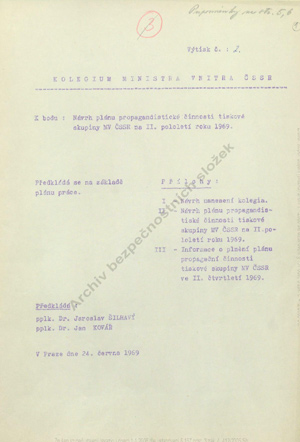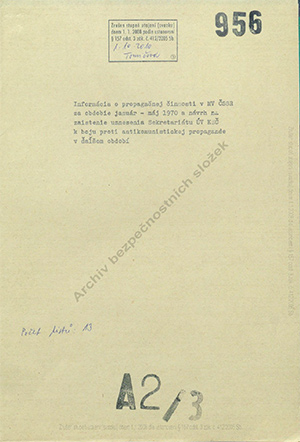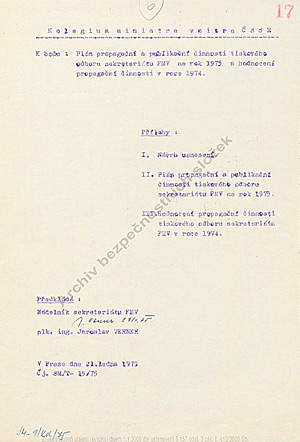(Dis)information war against its own people. A brief look at Czechoslovak history.
Introduction
A free and independent media (press, radio, television and the internet) are a fundamental prerequisite and one of the pillars of European society built on the principles of respect for human rights, freedom and democracy. Any attempt to control it in order to limit its independence would lead to the deterioration or destruction of free and independent news, and the erosion or even collapse of democracy. After 1989, the world of the media entered into a new, free and autonomous period and citizens had enough uncensored high-quality and lower quality content. After thirty years of relative press freedom, some fatigue in the material and society regarding development thus far has begun to show. In many respects, the advent of modern technology has replaced or displaced standard journalistic works based on verifying sources and facts.
Very quickly after the February takeover in 1948, the Communists limited freedom of movement and gained absolute control over all means of spreading information (the independent press, radio, printers, publishers, news agencies, etc.). Many political opponents fled and with the help of the press abroad continued the fight for a free Czechoslovak state. Except for a short period in 1968, strict censorship and press control reigned in Czechoslovakia. Propaganda and disinformation played a key role in supporting the ruling Communist Party, and in educating and indoctrinating the younger generation. However, there still remained ways to read, watch and listen to free and uncensored broadcasts. Despite strong interference in broadcasts by foreign stations, residents watched and listened to West German television, Austrian station ORF, the British BBC, the Voice of America, Radio Free Europe, Deutsche Welle, Vatican Radio and so on.
In this part we briefly describe additional institutionalized totalitarian instruments of state supervision, propaganda and disinformation in Czechoslovakia. Today's disinformation or alternative servers targeting Czech audiences had their predecessors in the "analogue era". Act No. 198/1993 Coll. – on the Illegality of the Communist Regime and on Resistance Against It pronounces that the Communist Party of Czechoslovakia, its leadership and members are responsible for the way of governance in our country between 1948 – 1989, especially for the purposeful destruction of traditional principles of European civilisation, for deliberate violations of human rights and freedoms, for moral and economic decline accompanied by judicial crimes and terror carried out against those with different opinions, for the replacement of a functional market economyby a directly controlled economy, for the destruction of traditional principles of property rights, for the abuse of education, science and culture for political and ideological purposes, for inconsiderate destruction of nature… This destruction of traditional values also concerned the freedom of speech and expression, and the right to seek and disseminate information and to express oneself without censorship and without restrictions.
Forty years of this deformation also left its imprint on the character of the people. For example, the decision of the Slovak Constitutional Court in October 2017 shows that the credibility of people working in the former StB is reduced. "The Constitutional Court notes that witnesses, …who were former members of the State Security of the Czechoslovak Socialist Republic, were actively involved in the promotion of the Communist regime. The working methods of State Security officers were, among other things, lies, and immoral and condemnable practices, and they did not hesitate to violate the basic principles of the democratic rule of law, international treaties and even their own laws to fulfil the aims of the Communist regime".1
The author of this text submitted a supplemented and extended version in the form of a paper at an international seminar Hybrid threats from the perspective of the Czech Republic and Ukraineon 27 May 2019 in the Chamber of Deputies of the Parliament of the Czech Republic.
If the concept of hybrid warfare seems to a part of the population, including the younger generation, like a new phenomenon, it is helpful to take a closer look and recall facts that demonstrate that before November 1989 Czechoslovakia was an active participant in the disinformation war on the side of the Soviet Union against the free world. Besides Enemy No. 1 - the United States of America and NATO countries, these activities were also directed against the population at home.
Today's Russia continues in its own traditions and is connected to its past and the common denominator is the continuity and legacy of the former intelligence services of the USSR and their activities.On 23 November 2016, the European Parliament adopted a resolution on EU strategic communication to counteract anti-EU propaganda by third parties, in which it states that it "is seriously concerned by the rapid expansion of Kremlin-inspired activities in Europe, including disinformation and propaganda seeking to maintain or increase Russia’s influence to weaken and split the EU“2
Control of information flow pursuant to the soviet model
After February 1948, under the direction of the Communist Party, institutionalized instruments for controlling and disseminating propaganda and disinformation abroad and towards its own population were fairly quickly established.All the way until the Velvet Revolution, in addition to the party line (Propaganda and Agitation Department of the Central Committee of the Communist Party, Department of Media and Mass Media of the Central Committee of the Communist Party), there was state apparatus dedicated to this activity, functioning under the curatorship of the party. Several articles were even published about this issue after 1989.3
For example, in 1951 the Minister of National Security ordered the press to be monitored by secret order → (TRMNB) No. 31/1951. A year later, Section VII of the Main Directorate of the StB for Censorship and Consignment Control was established by secret order →TRMNB No.165 / 1952. In 1953 - 1966 censorship was carried out by the Main Directorate for Press Oversight (Ministry of the Interior), followed by the Central Publication Office in 1966 - 1968, which ignored censorship in the short period between the Prague Spring in February 1968 and its abolishment on 4 March 1968 by the Central Committee presidium of the Communist Party. In the post-August period, the Press Section of the FMVwas established (later the Directorate for Political Training, Educational, Cultural and Propaganda Activities of the FMV- code named Directorate IX of the FMV), which was active from 1968 – 1988. Other important institutions included the Press and Information Office, which was established on 30 August 1968 and continued functioning until the end of 1989, and the Government Committee forPress and Information (1968 - 1980) and Federal Office for Press and Information from 1980 - 1989. As regards SNB units, Directorate VI of the FMV- Intelligence Equipment Directorate of the National Security Corps (SNB), which was in charge of the nationwide control of the population's mail, should also be mentioned.
By a government resolution on 23 April 1953, the Government of Czechoslovakia established the Main Directorate for Press Oversight (HSTD). This resolution also approved the statutes and set out the main tasks of the HSTD:
-
To ensure that there is no publication or dissemination in any way or by any means of data or facts containing state, economic or professional secrets within the meaning of the statutory provisions, or the publication of which are, according to Government Decrees of 15.7.1952 and 4.3.1953 and other regulations, inimical to the public interest;
-
To bolster the protection of state secrets and the responsibility for their preservation, thereby contributing to the defence and security of our republic and its socialist construction.
By a government resolution on 11 September 1953 the HSTD was placed under the Ministry of the Interior. The change in the statutes and organizational structure of the Main Directorate for Press Oversight of the Ministry of the Interior was brought about by a secret order of the Minister of the Interior Rudolf Barák dated 16 June 1955 → TRMV No. 107/1955.
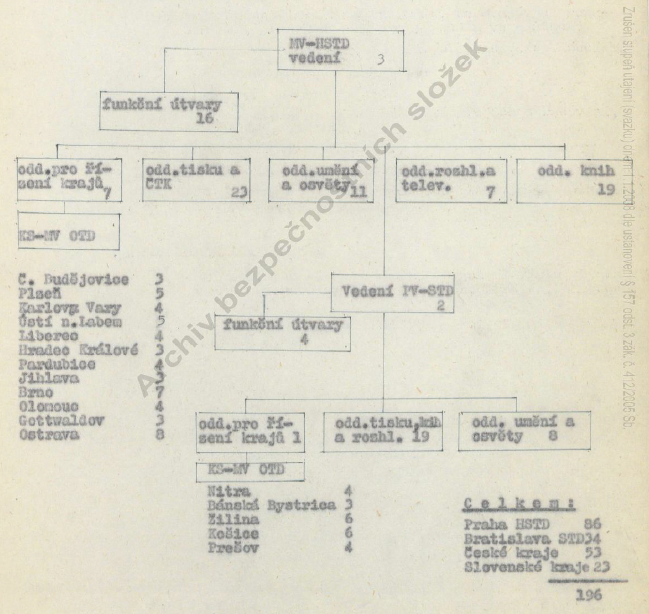
Fig.Organizations and numbers of the Ministry of the Interior HSTD and the Interior Commission of the STD as at 1 September 1956, source: ABS, f. A 2/1, inv. 1036.
This de facto amounted to directed control of all published content in the press, radio (television), art and education, and control of foreign correspondents in Czechoslovakia. The task was to filter out all expressions against the state, prevent the publication of information that might contain state secrets (which, with some exaggeration, included almost everything between 1948 and 1989) in the press and publish only approved content. The secondary goal was to prevent access to relevant information from journalists in the free world.
Over thirty years of Soviet experience went into the establishment of the HSTD. In February 1953, during his stay comrade I. A. Isachenko the Deputy Chief of the Main Directorate for the Protection of Military and State Secrets in the Press (Glavlit) of the Council of Ministers of the USSR ensured its transfer. (The original meaning of the acronym Glavlit came from Glavnoe Upravlenie po Delam Literatury i Izdatelstv – the Main Directorate for Literature and Publishing Affairs, which functioned all the way up until the dissolution of the USSR.)4
Glavlit directly and immediately directed and controlled the activities of individual censorship bodies throughout the Soviet Union. It aimed to prevent the publication of anything that could harm the interests of the USSR. Its task was to protect military and state secrets from the press and prevent the publication of materials aimed against the socialist system in the Soviet Union and against the policies of the Communist Party. It conducted inspections of publishing houses, editorial offices, the central press, the radio, the TASS state news agency, works of art, exhibitions, museums, central libraries, theatres, circuses and shows, cinemas, as well as all imported foreign literature and magazines (!).
Glavlit commenced functioning in 1922 and was directly subordinated to the central state authority of the Council of Ministers of the USSR. Its roots can be traced back to 1918. Later it was autonomous for a long time, then from March to October 1953 it briefly fell under the Ministry of the Interior but since 1954 was autonomous again. It was directly managed by the CPSU Central Committee, with branches in all republics and regions of the union. It worked very closely with the KGB.
From the very beginning, the Office controlled the activities of foreign correspondents accredited in the USSR.The material they sent was checked by Glavlit staff right at the main telegraph office. Each correspondent was required to submit 2 copies of their telegram message, one of which the censor obtained to ensure that the report did not contain any false or derogatory information about the USSR or disclose state or military secrets. In the event of "flawed text", appropriate amendments were made.Glavlit also informed the Ministry of Foreign Affairs about the activities and focus of foreign journalists.
Another task of Glavlit was to prevent the infiltration of enemy propaganda directed against the USSR and people's democracies, and its spread within the USSR. Therefore, from the very start, it inspected all capitalist publications imported into the USSR. However, materials addressed to the CPSU Central Committee, the Council of Ministers, the KGB and some other institutions were not subjected to review. The department responsible for this inspection was housed directly in theMoscow main post office, which most of these publications and materials passed through. There were similar workplaces in Leningrad, Brest and Čierná pri Čope (Ukrainian SSR).
By way of example, in 1956, 15 million different publications and magazines were imported into the USSR. Of these, 500,000 were relegated to a special archive and 70,000 were found to be entirely seditious and destroyed.However, one copy of each seditious specimen made its way into the archives of the V. I. Lenin State Library.
In 1957, Glavlit itself had 230 workers, plus 50 people in Moscow (Mosgorlit) and 2,000 in the regions.
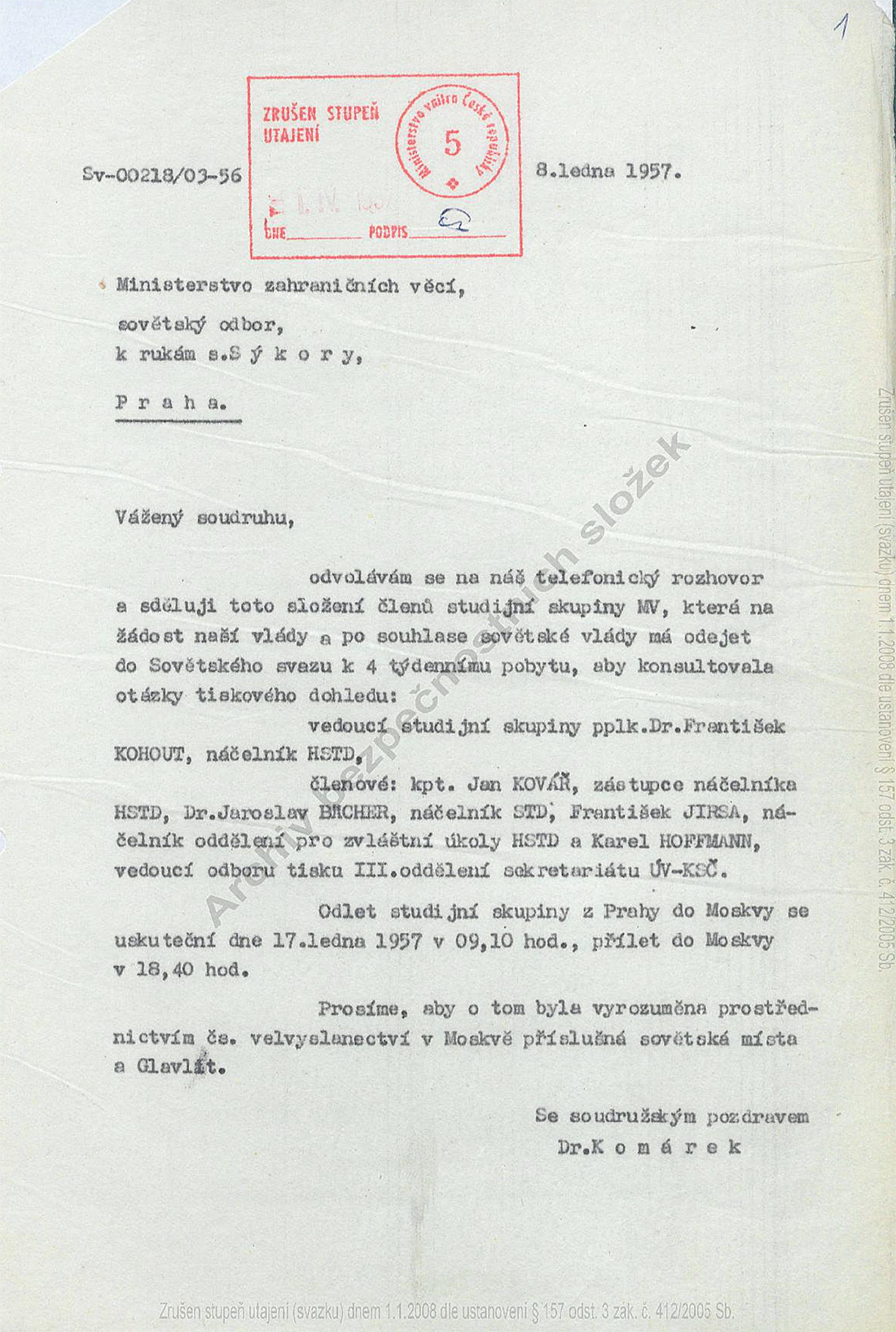
As at 1 September 1957, the Czechoslovak Main Directorate for Press Oversight had a total of 196 employees, of whom 86 worked in Prague (the largest section being the Press and ČTK (Czech News Agency) Department - 23 persons), 34 in Bratislava, and 53 and 23 people in the Czech and Slovak regions, respectively. In 1956, a total of 3374 interventions were carried out, of which 2180 were for political reasons (64.6%) According to information for 1963, 34.9% of censors only had primary school education, 16.8% had lower secondary school education, 32.9% had completed secondary school, and 15.4% tertiary education. Of these, 1.6% had been schooled in party politics and 23.4% of censors had graduated from the University of Marxism-Leninism.
HSTD's first chief was Lt. Col.František Kohout (appointed as central director of ČTK from 1 April 1961). After him, his deputy chief up until that point Major Eduard Kovařík became the second and last chief of the HSTD and Cpt. Jan Kovář took on the role of deputy chief. František Jirsa was the chief of the Office of Special Projects of the HSTD.
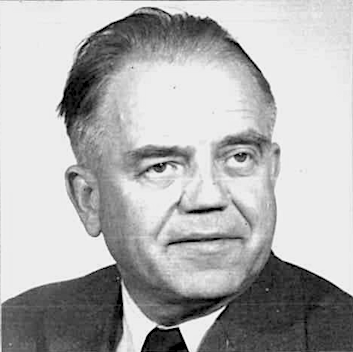 Lt.Col. Eduard Kovařík
Lt.Col. Eduard Kovařík
was born in 1904 in Strakonice. In 1917 he studied three years of middle school in Strakonice and trained as a waiter. In 1923 he joined the Czechoslovak KSČ (Communist Party) and during the war was a member of the illegal district organisation of the KSČ in Strakonice. He was imprisoned in camps in Terezín, Dresden, Waldheim and Flossenburg from 1940 to 1945 for his involvement.
After the war he completed the 2-month Central Political Journalism School of the KSČ and in 1955 he completed a 5-month course at the Party University of the Central Committee of the Communist Party.
In 1957 he joined the Ministry of the Interior as Deputy Chief of the HSTD with the rank of Major. On 1 April 1961 he was appointed Chief of the HSTD and on 1 May 1952 he was promoted to the rank of lieutenant colonel. In April 1967 he retired from the Ministry of the Interior.
Photo: ABS
In April 1958 on the occasion of the 5thanniversary of the establishment of the HSTD, in a speech to HSTD employees, Min. of the Interior Rudolf Barákstated, among other things: "In establishing press oversight, we have followed the Soviet model…"
We would be short-sighted if we were to allow, within our news and in fact the whole publishing and cultural awareness section, free reign for publishing news, without considering the preservation of state, military and economic secrets on the one hand, and party and government policies on the other. Control after the fact, after printing, after publication, is of little value, although it is possible to take action against the people responsible for such reports, as permitted by law…Since its inception, press oversight has not only had the function of “suppressing” flawed news in time,… a wide scope of action was reserved for educational and persuasive activities".
A new responsibility has been added to the current tasks of media oversight in the field of domestic press, radio, television, film, literature, fine art and education.That is the control of all published materials sent to us from foreign capitalist countries.This involves a considerable amount of printed matter. Much of it is sent to us through the "postal project" organized by Western imperialist circles after the failure of the "balloon action".This propaganda campaign is funded and organized by imperialist intelligence agencies of North Atlantic Treaty nations, especially the US. What is the "postal project"? Hostile printed content is sent to individuals, societies, factories and various institutions through the postal service.The addresses of our citizens are obtained from both telephone directories and through interviews with emigrants. In the second half of 1957 alone 24,593 copies of 145 different kinds of enemy materials were sent.Pamphlets, leaflets, magazines, books, brochures and other promotional material are sent in Czech and Slovak, or foreign-languages, promoting various revisionist ideas, Trotskyist views, religion, or exaggeratedly elevating technology, culture and the science of capitalist states, and above all, the American way of life, the failed "popular capitalism" and the universal defamation of the socialist world. The bulk of the materials come from the Federal Republic of Germany, France, the USA, Austria, Italy and England. One type of material is for example sent simultaneously from several countries; this is coordinated by one centre in the USA. Czechoslovak emigrants are also involved in this. In addition to the hostile materials of the "postal project", all manner of other printed materials are sent to us. …More than 25,000 of these materials arrive on our doorstep every month. A significant percentage of them comprise printed materials with religious content. Even though these magazines may contain claims that they are non-political materials, they are infused with bourgeois ideology.This stream of hostile propaganda that breaches our laws has nothing to do with cultural, scientific, and technical exchange, which we welcome and support.
The review of foreign publications was transferred to press oversight on 1 January 1958. The first positive results have already been seen this year and the first steps have been taken not only to stem the influx of these often harmful materials but, to actually use them for our counter-propaganda and for the purposes of our economic and scientific life.
We strive for peaceful coexistence. But this coexistence does not rule out the struggle of ideals; this remains. The point is, however, that the ideological struggle should not turn into a military conflict, nor be a source of hostility, but rather an initiator of peaceful competition between nations and world systems.
In addition to education, literature and art has played an important role in socialist re-education in the past.Press, radio and television have become significant cultural and educational forces…. There is hardly a family in the republic that is not influenced by at least one of these. This illustrates their great significance and the need for all these institutions to serve the people faithfully under the guiding hand of the party.The responsibility of all communists on the entire cultural front has been growing. This also applies to the Communists (that is to say virtually all workers) at press oversight. Socialism may be politically and economically established, but our struggle on the ideological front is not over yet.Such is the experience of class struggle, the transformation of a lower society into a higher society. That means – and this does not diminish the results of the work of press oversight – that your responsibility remains, because the forms of ideological struggle of our enemies and the errors and mistakes of those who stray are taking on an increasingly hidden face.
It will continue to be necessary for officers of press oversight to be uncompromising on key issues and to always be able to choose the right working methods, depending on the circumstances of the case, whether there was intention or mere error, whether it is a serious or minor matter, so that they are able to choose to educate or suppress.
Press oversight is part of the Ministry of the Interior and must strengthen its ties with the StB operations. Press oversight is a political instrument and must work completely under the control and direction of the party."
Central Publication Office
After the dissolution of the HSTD in 1966 and the adoption of Act No. 81/1966, censorship was legalized by law for the first time and was carried out by the Central Publication Office from 1966 – 1968. As a result of societal reform during the Prague Spring of 1968, media was unshackled from censorship and party control. The Office was entirely abolished in the spring of 1968, and in June of that same year censorship itself was abolished. All this was harshly criticised by the Soviet Union, and by domestic supporters of the old order.
Brezhnev in vain asked Dubček to have the Central Committee of the Communist Party again begin to manage and control the media. This happened only after the August invasion of occupation troops, when the Czechoslovak leaders pledged in the Moscow Protocol to get the media under their control again.
Resources of Communist Journalists (Czechoslovak Film Weekly, source: Czech Television (ČT))
The ABCs of Communist Crimes - Censorship (source: ČT)
Clipping freedom of the press 1968 - 1969 (source: ČT)
Press and Information Office
The government decided on the establishment of the Press and Information Office (ÚTI) on 30 August 1968 - three days after the return of Czechoslovak politicians from Moscow. This was the first step back towards the state of affairs as they had stood before January 1968.
The Office was tasked with managing, controlling and regulating the activities of the press, radio, television and ČTK in a uniform manner. The Office was at the same time to become the main point of contact between the government and the various editorial offices.Josef Vohnoutwas appointed as Director of the ÚTI.
The office needed 180 employees to function. However, it was very difficult to find a sufficient number of people willing to work there, so Josef Smrkovský suggested that journalists themselves do the censoring. They unambiguously and emphatically refused.
.The Office issued its first instructions on 3 September 1968, prohibiting journalists from criticizing the countries involved in the occupation and prohibiting the use of the terms "occupiers" and "occupation". In other instructions issued in October, the Office banned the reporting of the number of casualties and the damage caused by the occupying troops.
The establishment of the ÚTI was not sufficient, and therefore on 12 September 1968, the government set up a Government Press and Information Committee to monitor and evaluate the activities of the press, radio and television, to ensure compliance with the regulations for work in these media and to coordinate measures and guidelines as required by government policy. Deputy Prime Minister Peter Colotka was in charge of managing the committee.
A day later, on 13 September 1968, the National Assembly adopted the "Act on Certain Transitional Measures in the Area of the Press and Other Mass Media" (Act No. 127/1968 Coll.), which specified the form and point of existence of the Press and Information Office. ÚTI became a body of the state administration. The agenda of the Ministry of Culture and Information in the field of media was placed under it.
In addition, the Czech Press and Information Office (CTI) and the Slovak Press and Information Office (SÚTI) were established by the Act "in the interests of further peaceful development".
Act No. 127/1968 Coll. also reintroduced censorship. This time it was stricter than in the original form of Act No. 81/1966 Coll. on periodical press and on other mass media. A proxy function was established and the system of sanctions against publishers was extended (e.g. revocation of registration). ÚTI applied subsequent censorship, which led authors and publishers to self-censorship.
All measures and sanctions were applied by the CPC Central Committee department for party work in the media, and later by the mass media department of the CPC Central Committee.
The document provides more detailed information on the implementation of CPC Central Committee measures in the press, radio and television, towards the promotion of normalization of relations with the USSR and other countries of the Warsaw Pact, specifying individual measures…
Source: ebadatelna.cz
Ministry of Interior Press section documents
This unit was the gateway to the spreading of disinformation (active measures) towards the domestic audience (see also: Overview of disinformation and psychological operations of Czechoslovak intelligence around the world in 1965). Communist intelligence used a wide agency network at home and a number of methods of disseminating active measures in the form of articles, publications, and radio or television broadcasts against the United States, exile organizations and their leaders, etc. Some evidence is provided in the following documents.
Submitted by: Lt. Col. Dr. Ján Kovář, Lt.Col. Dr. Jaroslav Šilhavý
The document provides evidence of the specific activities of the Communist intelligence disinformation section towards the Czechoslovak public (see p. 5, points 16 and 19, where the responsible person is the Chief of the disinformation section (Lt. Col. Jan "Ostrovský" Ondrovčák and p. 7)
Source: ebadatelna.cz
The document introduces some operations aimed at a Czechoslovak audience. For example, the documentary Karty, které nevyjdou [Cards, which do get you out] by director Miroslav Hladký and then dean of the Faculty of Education and Journalism at Charles University in Prague (long-time collaborator of Directorate I Administration - IS ALTMAN) was prepared by the German section of political intelligence as active measure KALICH and broadcast on 15 May 1970 on Czechoslovak television. The documentary provided information "about the hostile acts of former Sudeten Germans against Czechoslovakia."
Submitted by: Lt.Col. Ján Kovář, Chief of the Press Section
Source: ebadatelna.cz
The part of the document evaluating 1974 provides in the part on state security issues, among other things, information about the "most successful" radio program Calls from the other side, which communist intelligence also participated in. This was active measure SAKURA against Radio Free Europe. (See the article: Conversations from the other side)
Submitted by: Lt.Col. Ing. Jaroslav Verner, Chief of the FMV Secretariat
Source: ebadatelna.cz
Prepared by Peter Rendek
1 The judgment of the Constitutional Court of the Slovak Republic II. ÚS 285/2017-163, can be found on the official website of the Constitutional Court: https://www.ustavnysud.sk
3 KAPLAN, Karel and TOMÁŠEK, Dušan. O cenzuře v Československu v letech 1945 – 1956. [About censorship in Czechoslovakia from 1945 – 1956]Prague: Ústav pro soudobé dějiny AV ČR, 1994; KAPLAN, Karel and VÁCHOVÁ, Jana. Z denních zpráv Hlavní správy tiskového dohledu 1957 - 1967. [From daily reports of the Main Directorate for Press Oversight from 1957 - 1967] Prague: ÚSD AV CŘ, 1995; KUROPATA Ondřej: Hlavní správa tiskového dohledu (1953-1956) [Main Directorate for Press Oversight], diploma thesis, Charles University in Prague, Faculty of Social Sciences, Institute of Communication Media and Journalism, Prague 2015, and others. See also totalita.cz.
4 More about Glavlit at: https://ru.wikipedia.org/wiki/Главное_управление_по_делам_литературы_и_издательств





